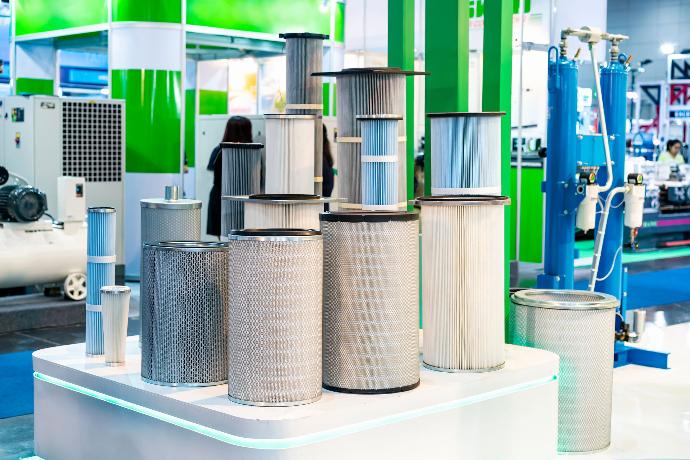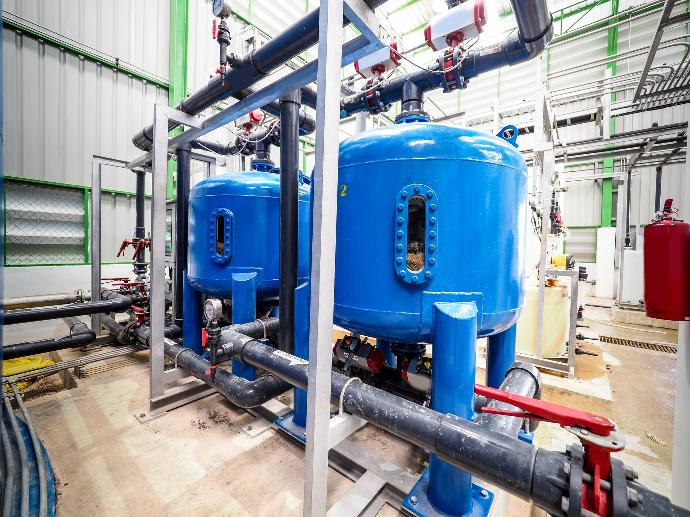Navigating the waters of water treatment reveals a spectrum of strategies, each with its own set of benefits and considerations. From the unwavering reliability of depth filters to the space-saving ingenuity of pleated filters, the filtration landscape is rich in options to meet diverse needs. Bag filters, sand filters, activated carbon filters, and screen filters add additional texture to this picture, each contributing a distinct hue to the canvas of clean water provision. As we embark on this exploration, we unravel the complexities, applications and financial dimensions of these filtration methods, illuminating their crucial role in safeguarding the clarity and purity of our most essential resource.
Depth Filter
Depth filters are indeed stalwarts in the water treatment filtration realm, valued for their durability and capacity to manage substantial dirt loads without rapid clogging. With pore sizes spanning from 1 to 100 microns, they provide a versatile spectrum of filtration capabilities. Unlike certain alternative filters, depth filters function by ensnaring particles within the porous framework of the filter media, effectively capturing contaminants across the entirety of the material's thickness.

One significant advantage of depth filters lies in their efficacy in applications demanding the removal of sediment, particles, and colloidal material. This makes them particularly suitable for pre-filtration tasks in reverse osmosis systems or in various industrial processes requiring meticulous particle filtration.
Moreover, the cost-effectiveness of depth filters should not be overlooked. While the initial purchase cost might vary depending on factors such as the specific material used for manufacturing and the size of the filter, their ability to handle high dirt loads without frequent replacement contributes to long-term cost savings. In comparison to some alternative filtration methods that might necessitate more frequent maintenance or replacement, depth filters offer a compelling cost-benefit ratio.
In terms of materials used for their manufacture, depth filters often leverage diverse materials such as cellulose, diatomaceous earth, or various synthetic fibers. This variety allows for customization based on the specific requirements of the filtration task at hand, ensuring optimal performance and longevity.
Furthermore, the robustness of depth filters enhances their operational efficiency, as they can endure high-pressure environments and maintain consistent performance over extended periods. This reliability is particularly valuable in industrial settings where continuous filtration is essential for smooth operations.
When considering recommendations for filtration systems, the versatility, effectiveness, and cost-efficiency of depth filters often make them a preferred choice. Their ability to handle diverse particle sizes, coupled with their durability and relatively low maintenance requirements, positions them as a dependable solution for various water treatment applications. Therefore, for those seeking a reliable and cost-effective filtration solution capable of addressing a wide range of contaminants, depth filters emerge as a compelling option.
Pleated Filter
Les filtres plissés sont réputés pour leur structure en accordéon, offrant une grande surface de filtration dans un design compact. Cette caractéristique de conception leur permet de piéger efficacement les particules à leur surface lorsque le fluide passe à travers, assurant une filtration efficace sur une large plage de tailles de pores, de 0,1 à 100 microns.

However, it's essential to acknowledge that pleated filters may be susceptible to clogging under high levels of particulate matter. Despite this drawback, they remain widely utilized in residential, commercial, and industrial settings for both water and air filtration purposes.
In terms of materials used for their manufacture, pleated filters often incorporate materials such as polyester, polypropylene, or fiberglass. These materials offer durability and compatibility with various filtration tasks, ensuring reliable performance over extended periods.
When considering the costs associated with the use and purchase of pleated filters, several factors come into play. While the initial purchase cost might vary depending on factors such as the size, material composition, and pore size of the filter, pleated filters generally offer a cost-effective solution due to their longevity and high surface area for filtration. Additionally, their ability to efficiently trap particles on the surface can lead to extended intervals between replacements, contributing to overall cost savings in the long run.
Despite the potential for clogging under high particulate matter levels, the versatility, durability, and cost-effectiveness of pleated filters often make them a preferred choice in various water treatment applications. Their ability to provide efficient filtration within a compact design, coupled with their widespread use across residential, commercial, and industrial sectors, underscores their effectiveness and reliability. Therefore, for those seeking a filtration solution that balances performance, durability, and cost-effectiveness, pleated filters stand out as a compelling option.
Bag Filter
Bag filters, characterized by their bag-like structure, offer a reliable solution for water treatment filtration tasks, leveraging fabric or synthetic material to trap particles effectively. Their pore sizes typically range from 1 to 200 microns, allowing for efficient filtration of varying particle sizes while accommodating high flow rates and large volumes of water.

However, it's important to note that bag filters may require frequent replacement or cleaning, especially when subjected to high contamination levels. Despite this potential drawback, their effectiveness in handling high flow rates and large volumes of water outweighs the need for periodic maintenance.
In terms of materials used for their manufacture, bag filters typically utilize fabric or synthetic materials such as polyester, polypropylene, or nylon. These materials offer durability and compatibility with a wide range of filtration tasks, ensuring reliable performance in various industrial and water treatment applications.
When considering the costs associated with the use and purchase of bag filters, several factors come into play. While the initial purchase cost may vary depending on factors such as the size, material composition, and pore size of the filter, the efficiency and durability of bag filters contribute to long-term cost savings. Additionally, their ability to handle high flow rates and large volumes of water reduces the need for frequent replacements, further enhancing cost-effectiveness.
In summary, the robustness, efficiency, and versatility of bag filters make them a recommended choice for water treatment applications, particularly in industrial settings where high flow rates and large volumes of water are common. Despite the potential for periodic maintenance, their ability to effectively trap particles and accommodate varying contamination levels positions them as a reliable filtration solution. Therefore, for those seeking a filtration solution capable of handling high flow rates and large volumes of water with efficiency and reliability, bag filters emerge as a compelling option.
Sand Filter
Sand filters utilize the inherent filtration properties of sand media to effectively remove particles from water, making them a staple in water treatment applications. Their effectiveness is particularly notable in capturing particles larger than 20 microns, providing reliable filtration in various settings.

However, it's essential to acknowledge that sand filters require periodic backwashing to maintain their efficacy. This process involves reversing the flow of water through the filter to dislodge trapped particles and refresh the sand media. While backwashing is necessary for upkeep, it adds to the operational requirements of sand filters.
In terms of materials used for their manufacture, sand filters primarily consist of a tank or vessel filled with specially graded sand media. The sand acts as the primary filtration medium, effectively trapping particles as water passes through. Additionally, the tank is typically constructed from durable materials such as fiberglass or stainless steel to withstand the pressure and demands of continuous filtration operations.
When considering the costs associated with the use and purchase of sand filters, several factors come into play. The initial purchase cost may vary depending on factors such as the size of the filter vessel, the quality of materials used, and any additional features incorporated into the design. Additionally, ongoing maintenance costs, including the expense of backwashing and occasional sand replacement, should be taken into account when evaluating the overall cost-effectiveness of sand filters.
Despite the need for periodic maintenance, the effectiveness, robustness, and ability to handle high flow rates and volumes of water make sand filters a recommended choice for water treatment applications. Their natural filtration capabilities, coupled with their reliability in diverse settings, position them as a dependable solution for removing particles from water. Therefore, for those seeking a filtration solution capable of providing efficient particle removal and withstanding demanding conditions, sand filters emerge as a compelling option.
Activated Carbon Filter
Activated carbon filters excel in removing organic compounds, chlorine, and specific chemicals from water through adsorption, making them indispensable in water treatment applications. Their effectiveness stems from micropores ranging from 0.5 to 50 nanometers, enabling precise filtration tailored to target contaminants with exceptional efficiency.

However, it's important to note that activated carbon filters may require periodic replacement or regeneration to maintain their effectiveness. Over time, the adsorption capacity of the carbon media may diminish, necessitating replenishment or regeneration to ensure continued performance.
In terms of materials used for their manufacture, activated carbon filters primarily consist of activated carbon granules or blocks housed within a filtration vessel. The activated carbon is derived from various sources, including coconut shells, wood, or coal, and undergoes a process to activate its adsorptive properties. Additionally, the filtration vessel is typically constructed from materials such as plastic or stainless steel to withstand the demands of water treatment operations.
When considering the costs associated with the use and purchase of activated carbon filters, several factors come into play. The initial purchase cost may vary depending on factors such as the size of the filter vessel, the quality of activated carbon used, and any additional features incorporated into the design. Additionally, ongoing maintenance costs, including the expense of periodic replacement or regeneration, should be considered when evaluating the overall cost-effectiveness of activated carbon filters.
Despite the need for periodic maintenance, the effectiveness, versatility, and tailored filtration capabilities of activated carbon filters make them a recommended choice for water treatment applications. Their ability to remove specific contaminants with precision, coupled with their broad range of applications, positions them as a reliable solution for addressing diverse water treatment challenges. Therefore, for those seeking a filtration solution capable of targeted contaminant removal and adaptable to various water treatment needs, activated carbon filters emerge as a compelling option.
Conclusion
In the labyrinth of water treatment filtration, we have traversed a landscape rich with diversity, where each filtration method adds its own brushstroke to the canvas of clean water provision. From the robust reliability of depth filters to the versatile efficiency of pleated filters, and from the enduring resilience of bag filters to the precision targeting of activated carbon filters, the array of options available underscores the importance of tailoring filtration strategies to specific needs.
While each method carries its own set of advantages and considerations, they collectively serve a common purpose: ensuring the purity and safety of our most vital resource. As we conclude this exploration, it becomes evident that the key to effective water treatment lies not in a singular approach, but in the judicious selection and integration of filtration techniques that best address the unique challenges of each application.
In the ever-evolving landscape of water treatment, innovation continues to drive progress, offering new solutions and refining existing ones to meet the evolving demands of industry, commerce, and society. As stewards of our water resources, it is incumbent upon us to embrace these advancements, not only to safeguard the quality of water today but also to secure its abundance and accessibility for generations to come.